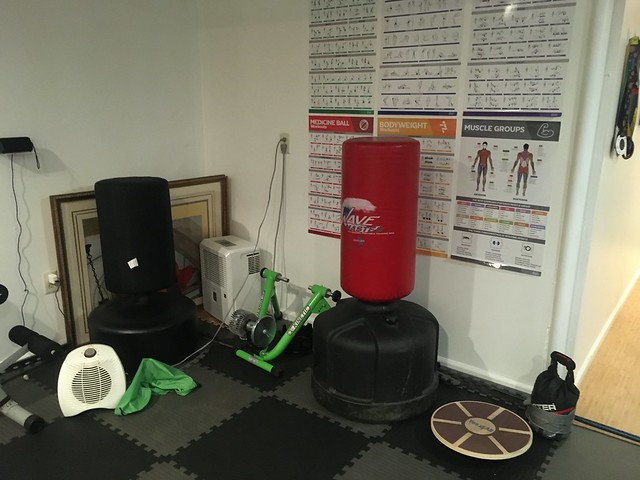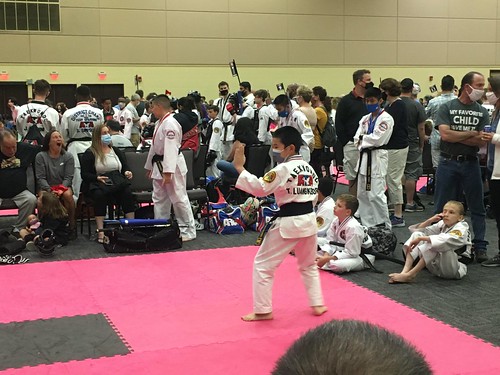The Basement Gym Equipment
Here is the current state of the basement gym. When we bought this house, we decided to make the basement a gym (the previous owner basically used it as a messy closet), so we had ordered mats that would arrive just after we moved (and before the movers moved our stuff). So the main part of the basement was immediately covered in 3/4" mats suitable for exercise.

The floor is the main feature. The open floor is meant for TKD, so it is always (ha!) clear to do forms. And we move equipment there as needed. The floor is used for our workouts (usually CrossFit or HIIT style workouts), my daughter uses it to dance to music and music videos. In the corner is the screen with an Amazon Fire stick. Two bluetooth speakers on the walls provide surround sound music for the workout. The shelves in the corner hold any electronics (remotes, timers, HRM chest strap), accessories, and mobility equipment (foam roller, lacross balls, yoga blocks). Also along the wall are a pylo box (home made) and steppers (garage sale)
A new addition is along the wall with the mirrors and whiteboard (which is now hanging). We have hooks that we use for resistance band training. We have started using resistance bands for swimming dryland training, so the bands are clipped into the hooks, and we can practice our strokes, either on our back, or using the weight bench. I also use the upper hooks to do ski-erg type motions.

This corner has all of the TKD equipment. In addition to two Century Wavemaster standing bags for striking and kicking, we have kick and hand targets for taekwondo. Also various ATA TKD weapons. Also important are the posters. We have posters for kettlebell, medicine ball, bodyweight, stretches, foam roller, anatomy, (and other wall) dumbbell, barbell, suspension band, and cable machine, along with posters illustrating the foundational powerlifting and Olympic lifts. And various card decks with exercises when we need to build a semi-random circuit workout.

Another new addition is the bike trainer. I got a
Kinetic Road Machine off of Facebook Marketplace over the summer (someone was selling it for her brother-in-law, so the goal was to clear it out of the hosue) I added the Inride Power Meter, and now I have a bike trainer that measures power (previously, I used the calories estimated by my HRM to measure power) Training to power adds a new dimension to training, and a third cardio machine, because power meters measure output, as opposed to the HRM, which effectively measures input (effort), which as any engineer knows, is not what you should be measuring. I have been using it with the Kinetic.fit app to record power based workouts. I do this once or twice a week (depending on if I use this for the Streetparking Endurance workout for the week)

Here is the equipment nook. This area is organized around the power rack and its mats. I have a standard bar (1" diameter weights), with about 250 lbs of weights for use with a barbell, dumbbells, and an adjustable kettlebell that is usually loaded up to 30-40 lbs of weight. I also have three sand kettlebells (10#, 15#, 20#) that the kids use and I use for warmups. And there are two sandbags, a 50# and a 65# that I joke are great for when I need to feel particularly badass :-). I have a suspension trainer on the back upper bar that I will use for warmups. And a new addition is a cable pully I have on the front upper bar for cable exercises (also using standard plates)
For cardio we have two machines, a magnetic rower and an airdyne. My son has started using these as well, although he is not quite tall enough. For longer workouts, he can use the rower, (because I don't like using the Airdyne for workouts > 30 minutes, I usually pull out the bike trainer for these.)
What we do
This was the COVID-19 pandemic year, which meant that schools became virtual, and even after school activities struggled to figure out how to work with the kids. Some places really did not figure this out, others went all in to remote (video) training, and others basically became video classes (no interaction). We had an immense advantage that my main fitness programming was Streetpakring (
https://streetparking.com/), which is an online CrossFit style programming. So I'm used to this. My daughter is used to joining me on my workouts (I scale, so she scales too). And now she discovered the Just Dance series of games, and now dances for hours on end, so she is taken care of. My son was a little harder. His TKD first stopped completely, and his school did not really get the hang of the virtual teaching, so we have been trying to get a routine. So now, we have 4 types of workouts over the week.
1. 20 minutes of intervals (0:30/0:30, 0:40/0:20, 1/1, 0:90/0:30) (rower or airdyne)
2. Dryland bodyweight HIIT (usually a 20 minute video aimed at swimmers, but SP Shift is also an option.
3. Resistance band
4. Long, either ~40 minute run or 40 minutes of intervals (rower)
Streetparking
Streetparking is an online CrossFit style programming (constantly varied across broad modal and time domains) aimed at home gym owners. It has two mantras: more than nothing, and consistency is key. The center piece are the CrossFit style workouts. 5 days a week there are 4 versions, A (dumbbell centered), B (barbell centered) and C (sandbag or other odd object based), and shift (simpler movements for those who have not mastered the movement. They are big on scaling with options for movements to match available equipment and skills that maintain the stimulus. Next, there are accessories workouts, strength focused (power, olympic, and sandbag), skillwork (gymnastics), endurance, and, for those who just can't get away from gym bodybuilding workouts, accessories for that.
They have a very wide range of people doing this, the two largest populations are (1) stay at home moms and (2) active military (and families). So their mantra is More than nothing, meaning they encourage everyone to do what is intense for them (weight, reps, movements). (intensity is the another component of CrossFit) And the generally accepted way of knowing that you got the intensity right, you complete the workout in the goal time and you die (or as DD6 knows, you plop at the end of a workout)
But what makes Streetparking different than other online programs is the amount of interaction between the members. The focus is on the Facebook and Instagram accounts associated with Streetparking, and members are encouraged to video workouts and post them. As many people are unwilling to put themselves out in the public (because people on the Internet in general are strange), many people create private accounts or have accounts that are solely for Streetparking, and will only connect to other people who are also in Streetparking (there is a Streetparking account for publicity purposes, and another account that only follows Streetparking members, so we know to look for that to identify each other). And it very clearly is not meant to be a focused on the strongest, but on those who maintain intensity. There is the CrossFit vibe of always cheering on those who struggle through (regardless of what that means), and in posts, I think one of the rewards of honesty is reading others reports of workouts, and saying "that is what I was feeling, at the exact same point in the workout". So social media becomes a lot of "me two" types posts, which builds that sense of shared community, that is missing in places that try to deliver video to people working at home. And the sheer range of people involved. I feel that Streetparking has the broadest cross-section of people out of any association I am in, and it encourages using it as a place where people can have conversations about life (with a little bit of moderation to move any antagonistic conversations elsewhere). For example as COVID-19 made its way to through the U.S. and different states had different experiences, members from the various areas discussed their experiences dealing with life, the shutdowns, and getting (and recovering) from COVID (and occasionally a story that someone did not). The type of connection that keeps us all sane in a time when we don't get enough face to face interaction, and one way video interaction does not provide.
















